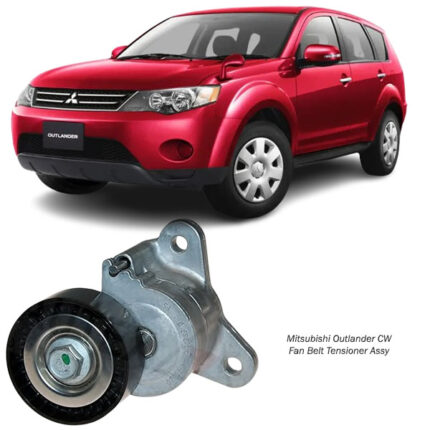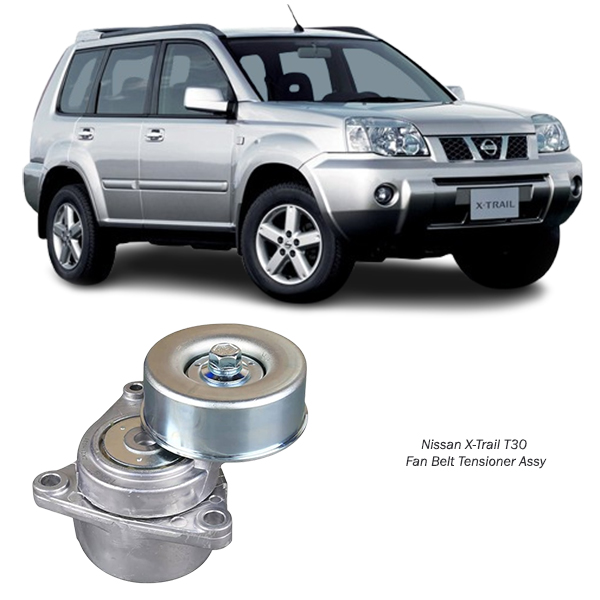-8%
Get Nissan X-Trail T30 Fan Belt Tensioner Assy 119556n20b in Kenya
The fan belt tensioner assembly (commonly referred to as a serpentine belt tensioner) is a crucial component in modern automotive engines. This assembly maintains the proper tension on the fan belt (or serpentine belt), ensuring it effectively drives various engine accessories, including the alternator, air conditioning compressor, water pump, and power steering pump. Without a functioning tensioner, the belt system cannot operate efficiently, leading to performance issues or potential engine damage.
This detailed guide explores the fan belt tensioner assembly’s structure, functions, benefits, signs of wear, maintenance, and replacement procedures.
What is a Fan Belt Tensioner Assembly?
The fan belt tensioner assembly is a spring-loaded or hydraulic device designed to maintain consistent tension on the serpentine belt. It consists of:
- Pulley: A smooth or ribbed wheel that guides and supports the belt.
- Spring Mechanism: Provides the force necessary to keep the belt taut.
- Arm: The lever that supports the pulley and allows it to move as needed.
- Housing: Encases the spring mechanism and provides structural stability.
This assembly is engineered to automatically adjust belt tension as the belt stretches or contracts due to temperature changes or wear.
How Does a Fan Belt Tensioner Work?
When the engine runs, the serpentine belt drives multiple components by transferring rotational force. Over time, the belt undergoes stretching due to wear, load variations, and temperature changes. The fan belt tensioner adjusts its position dynamically to maintain the proper amount of tension.
- Spring-Loaded Tensioners: Use an internal spring to exert force, automatically adjusting as the belt moves.
- Hydraulic Tensioners: Use pressurized hydraulic fluid for smoother and more precise tension adjustments.
Functions of a Fan Belt Tensioner Assembly
- Maintains Proper Belt Tension
Ensures the serpentine belt stays taut to efficiently drive connected accessories. - Prevents Belt Slippage
Keeps the belt aligned with pulleys, preventing it from slipping or disengaging. - Reduces Wear
Adjusts dynamically to minimize excessive wear and tear on the belt and connected components. - Absorbs Vibrations
Damps vibrations caused by the belt’s movement, ensuring quieter operation and reducing strain on other components. - Supports Engine Accessories
Guarantees the smooth operation of essential components like the alternator, water pump, and air conditioning compressor.
Benefits of a Fan Belt Tensioner Assembly
- Consistent Engine Performance
Proper belt tension ensures all accessories function as intended, maintaining optimal engine performance. - Enhanced Belt Longevity
Reduces premature belt wear by ensuring consistent alignment and tension. - Improved Safety
Prevents sudden belt failures that could lead to loss of power steering or overheating, ensuring safer driving conditions. - Reduced Maintenance Costs
A properly functioning tensioner prevents damage to expensive components like the alternator or water pump. - Quieter Operation
Eliminates squealing or rattling noises caused by a loose or misaligned belt.
Signs of a Faulty Fan Belt Tensioner Assembly
- Unusual Noises
- Squealing, chirping, or grinding sounds often indicate a failing tensioner or misaligned pulley.
- Rattling sounds may suggest a loose or worn tensioner arm.
- Belt Slippage
A loose tensioner allows the belt to slip off the pulleys, causing erratic performance or accessory failure. - Visible Belt Damage
Fraying, cracking, or glazing on the belt can result from improper tension. - Engine Accessories Malfunction
Faulty tensioners can cause intermittent or complete failure of components like the alternator or power steering. - Vibrating Belt
Excessive belt vibration or wobbling during operation indicates insufficient tension. - Check Engine Light
A malfunctioning tensioner may trigger warning lights if engine components stop functioning properly.
Causes of Fan Belt Tensioner Failure
- Normal Wear and Tear
Over time, the tensioner’s spring loses strength, reducing its ability to maintain proper belt tension. - Exposure to Contaminants
Dirt, oil, and moisture can degrade the tensioner’s moving parts or compromise the spring mechanism. - Improper Installation
Incorrect alignment during installation can accelerate wear on the tensioner and belt. - Excessive Heat
Prolonged exposure to high engine temperatures weakens the tensioner’s materials. - Belt Issues
A damaged or overly tight belt can place undue stress on the tensioner, causing premature failure.
Maintenance Tips for Fan Belt Tensioner Assembly
- Inspect Regularly
Check the tensioner and belt during routine servicing for signs of wear, misalignment, or damage. - Monitor Belt Condition
Replace the serpentine belt at the manufacturer-recommended intervals or if visible damage occurs. - Check Pulley Alignment
Misaligned pulleys can cause uneven wear on the tensioner and belt. - Keep Components Clean
Prevent oil, dirt, or debris from accumulating on the tensioner or belt. - Replace When Necessary
Replace the tensioner if the spring weakens, the pulley wears out, or unusual noises develop.
Replacement of Fan Belt Tensioner Assembly
Replacing a fan belt tensioner assembly is a straightforward process but requires proper tools and expertise.
Tools Needed:
- Ratchet wrench and socket set
- Serpentine belt tool or breaker bar
- New tensioner assembly
- Replacement serpentine belt (if needed)
Steps:
- Disconnect the Battery
Ensure safety by disconnecting the negative battery terminal. - Locate the Tensioner
Refer to the vehicle’s service manual to identify the tensioner’s position. - Release Belt Tension
Use a serpentine belt tool or breaker bar to rotate the tensioner and relieve tension on the belt. Slide the belt off the pulleys. - Remove the Old Tensioner
Unscrew the mounting bolts securing the tensioner to the engine block. Remove the old assembly. - Inspect Related Components
Check the pulleys and serpentine belt for wear or damage, replacing them if necessary. - Install the New Tensioner
Position the new tensioner assembly and tighten the mounting bolts to the manufacturer’s specifications. - Reinstall the Belt
Follow the belt routing diagram to correctly position the serpentine belt over the pulleys. - Apply Tension
Rotate the tensioner to apply tension to the belt, ensuring it is properly seated on all pulleys. - Reconnect the Battery
Reconnect the negative terminal and start the engine to verify proper operation. - Test Drive
Check for unusual noises or belt movement while driving.
When to Replace the Fan Belt Tensioner Assembly
The lifespan of a fan belt tensioner varies depending on driving conditions and maintenance. Typically, it should last between 60,000 and 100,000 miles. Replace it if:
- The tensioner exhibits signs of wear or damage.
- The belt slips or shows visible signs of stress.
- Unusual noises persist despite belt replacement.
Cost of Replacement
The cost of a fan belt tensioner assembly ranges from $50 to $200, depending on the vehicle make and model. Labor costs may add an additional $100 to $200 if replaced by a professional.
Conclusion
The fan belt tensioner assembly is vital for maintaining proper belt tension and ensuring the smooth operation of engine accessories. Regular inspections, timely replacements, and proper maintenance are essential to avoid costly repairs and ensure optimal engine performance. By understanding its function and importance, you can prolong the life of your vehicle and enjoy a safer, quieter, and more reliable driving experience.
Follow us on Facebook for more parts.





